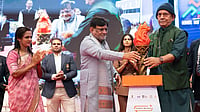
Beijing hosts the inaugural World Humanoid Robot Games in August 2025
Over 500 humanoid robots from 280 teams will compete
Events include robotic football, running, dancing competitions, and many more
The first World Humanoid Robot Games in Beijing, China, kicked off on Friday (August 15, 2025). The three-day event will showcase the latest advancements in humanoid robotics, with over 500 advanced bipedal robots competing.
The event sets a new precedent for international robotics competitions and signals rapid technological advancement. "Each participating robot is creating history," officials affirm, as quoted by China’s official newspaper People’s Daily, marking a milestone in the integration of robotics and AI in sports and entertainment.
Landmark Humanoid Robot Sports Event
The World Humanoid Robot Games initiative promotes integration of robotics and artificial intelligence into sports and public entertainment, according to reports. These 'Games' are part of a broader push by China and the international robotics community to advance humanoid robotics research and enhance public acceptance.
Organisers emphasise both technical achievement and community engagement, demonstrating how close robots are to achieving human-like agility and performance across sporting, artistic, and social contexts.
Alongside the competitive events, the Panda Eye venue and its adjacent robotics camp engage the public through live performances, impromptu demonstrations, and even robot-operated cafes, making cutting-edge technology accessible to local communities.
Technology leaders view the Games as a breakthrough in embodied AI and a milestone for real-world human–robot interactions in dynamic sports and cultural contexts.
Global Participation And State-Of-The-Art Venues
Over 500 humanoid robots are in the fray, representing 280 teams selected from between 16 to over 20 countries, including China, the United States of America, Germany, and Japan.
Participants range from leading robot technology firms and prestigious universities such as Tsinghua University and Peking University to research institutes and even middle schools.
The main venue is the National Speed Skating Oval, also known as the Ice Ribbon, which previously hosted events during the 2022 Beijing Winter Olympics. Adjacent to the main arena, the newly established Panda Eye provides a dedicated space for robot competitions and training, supporting pre-match preparation and technology testing.
Diverse Competitions And Rigorous Regulations
The first World Humanoid Robot Games feature a broad range of sports, including robotic football, running, boxing, martial arts, badminton, basketball, table tennis, free gymnastics, standing long/high jump, and both solo and group dance events.
These competitions will test both engineering sophistication and AI-driven autonomy; for example, gymnastic and dance events require full autonomous operation, while other events permit manual or remote control.
Strict regulations mandate that only authentic bipedal humanoid robots, with a defined torso and limbs, participate. Robots must operate on internal energy sources without external assistance for jumping, and substitutions during competitions are forbidden.
Competing robots are evaluated for movement stability, agility, and their ability to interact with the environment and human participants, with demonstration events such as fashion shows and interactive performances.
Meanwhile, the ROBO League football tournament in Beijing concluded last month. Regarded as the premier humanoid robot contest in Asia-Pacific, the event attracted 30 international teams, with the THU Robotics from Tsinghua University beating the Mountain Sea from China Agricultural University 5-3 in the final. It served as the first test match for the World Humanoid Robot Sports Games.



























